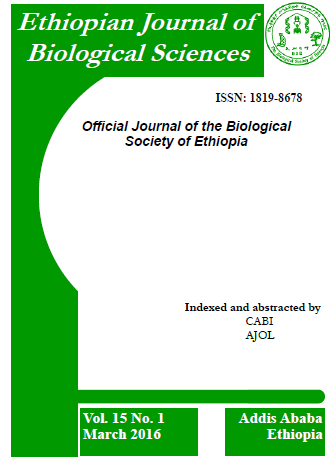WATERLOGGING EFFECTS ON GROWTH, NODULATION AND PRODUCTIVITY OF DESI AND KABULI CHICKPEA (CICER ARIETINUM L.)
Abstract
Early planting against terminal drought and increase in precipitation extremes due to climate change may expose chickpea production to transient waterlogging. Desi and kabuli type chickpea were subjected to 10 days waterlogging during three phases to assess relative sensitivity among phases and between genotypes and to identify traits that may contribute for performance under the stress. Waterlogging increased stomatal resistance with full conductance recovery made only after relief from early waterlogging. The desi type maintained consistently greater stomatal resistance against waterlogging. Root growth and nodulation were most resilient to early stress while irreversibly destroyed by mid and terminal waterlogging. On the other hand, aboveground vegetative growth suffered most from early and mid waterlogging while it was not affected by terminal stress. A moisture by genotype interaction showed that the desi type suffered a 21% loss in seed yield while the kabuli lost almost twice as much, 39%. The flowering phase was most susceptible to waterlogging followed by seed-filling irrespective of chickpea type with mean reductions of 97% and 56%, respectively. Susceptibility of the flowering phase was due to large flower abortion, severe root and nodule degradation, shortened seed filling duration, detrimental leaf senescence and persistently high stomatal resistance. Relative tolerance of desi type against vegetative waterlogging for yield performance may be associated with fast recovery from chlorosis, increased pod production on the main stem and better nodulation capacity. It seems that the desi genotype, Naatolii, can be a better choice when risk of early waterlogging is anticipated from early planting or weather variability.
References
Abuhay Takele and McDavid, C.R. (1995). The response of pigeonpea cultivars to short durations of waterlogging. Afr. Crop Sci. J. 3: 51–58.
Ashraf, M., and Chishti, S.N. (1993). Waterlogging tolerance of some accessions of lentil (Lens culinaris Medic.). Trop. Agr. Trin. 70(1): 60–67.
Askalech Fikadu (2014). Performance of Chickpea Varieties (Cicer arietinum L.) under Inoculation with Different Rhizobium Strains at Meskan Woreda, Southern Ethiopia. M.Sc. Thesis, Hawassa University, Hawassa.
Bansal, R. and Srivastava, J.P. (2012). Antioxidative defence system in pigeonpea roots under waterlogging stress. Acta Physiol. Plant. 34: 515–522.
Cowie, A.L., Jessop, R.S. and MacLeod, D.A. (1996). Effects of waterlogging on chickpea I. Influence of timing of waterlogging. Plant Soil. 183: 97–103.
CSA (Central Statistical Agency) (2013). Agricultural Sample Survey 2012/2013: Report on Area and Production of Major Crops (private peasant holdings, meher season). Statistical bulletin 532, Ethiopia.
More inside the PDF
